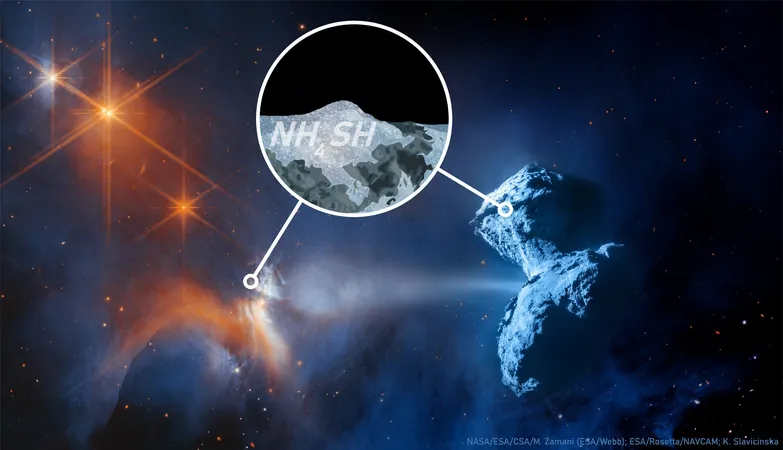
Unveiling the Cosmic Mystery: Where Has All the Sulfur Gone?
2025-01-16
Author: Mei
Unveiling the Cosmic Mystery: Where Has All the Sulfur Gone?
In an exciting breakthrough, an international team of astronomers led by researchers from Leiden University has revealed that lost sulfur in the universe may actually be hiding in plain sight — within salt found on cosmic dust and pebbles. This discovery not only sheds light on the age-old mystery of vanishing sulfur gas but also addresses unusual data observed by the James Webb Space Telescope’s mid-infrared instrument (MIRI).
The study published in the journal Astronomy & Astrophysics takes a close look at two perplexing questions that have puzzled scientists for over two decades. First, the astronomers noted that dense clouds and star-forming regions contain far less volatile sulfur than the more sparsely populated interstellar spaces. Second, they encountered a mysterious peak in the infrared spectrum that seemed to lack a logical explanation.
The researchers suggest that this sulfur mystery may be resolved through the reaction of ammonia (NH3) and hydrogen sulfide (H2S), which, under icy cosmic conditions, forms ammonium hydrosulfide (NH4SH) salt. Their laboratory experiments simulated extreme cold conditions found in space, where limited molecular reactions could occur around dust particles embedded in icy environments.
The results were startling. The experiments showed that when ammonia and hydrogen sulfide join together in these ices present around dust and pebbles, they form ammonium hydrosulfide very quickly. This implies that much of the volatile sulfur believed to be missing is actually trapped within those cosmic dust aggregates.
Moreover, the salt produced by this reaction aligns perfectly with the previously unexplained peak identified in data from the James Webb Space Telescope. This peak hints that up to 20% of the elusive sulfur compounds could be sequestered in the form of ammonium hydrosulfide salt within dust and pebbles scattered throughout star-forming regions.
“I think it is great that we are finally unraveling both mysteries,” stated Katie Slavicinska, a Ph.D. student at Leiden University and the lead author of the study. “With our research, we are killing two birds with one stone.”
This illuminating research was spurred by findings from the European Space Agency's Rosetta mission, which discovered unexpectedly high levels of ammonium hydrosulfide in dust particles of comet 67P. The team's insight led to the logical assumption that if comets store pristine icy materials from the early solar system, then looking to star-forming regions for ammonium hydrosulfide was the next step in unraveling the cosmic sulfur enigma.
Adwin Boogert, co-author and a Dutch scientist based at the University of Hawaii at Manoa, remarked, “It’s thrilling to see how we can increasingly trace chemical signatures back from our current solar system to the origins of new solar systems.”
This groundbreaking discovery not only provides answers to long-standing questions about the universe's composition but also showcases the incredible ability of science to connect dots across time and space. What else could be lurking within the cosmic dust waiting to be discovered? Stay tuned as the universe continues to unveil its secrets!


 Brasil (PT)
Brasil (PT)
 Canada (EN)
Canada (EN)
 Chile (ES)
Chile (ES)
 Česko (CS)
Česko (CS)
 대한민국 (KO)
대한민국 (KO)
 España (ES)
España (ES)
 France (FR)
France (FR)
 Hong Kong (EN)
Hong Kong (EN)
 Italia (IT)
Italia (IT)
 日本 (JA)
日本 (JA)
 Magyarország (HU)
Magyarország (HU)
 Norge (NO)
Norge (NO)
 Polska (PL)
Polska (PL)
 Schweiz (DE)
Schweiz (DE)
 Singapore (EN)
Singapore (EN)
 Sverige (SV)
Sverige (SV)
 Suomi (FI)
Suomi (FI)
 Türkiye (TR)
Türkiye (TR)
 الإمارات العربية المتحدة (AR)
الإمارات العربية المتحدة (AR)